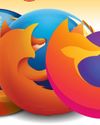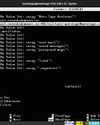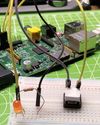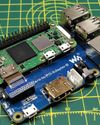Slackware 15.0
Linux Format
|April 2022
He’s no masochist… until there’s a new Slackware release, when Mayank Sharma puts himself through all kinds of pains to relive the good ol’ days.

IN BRIEF
Slackware was created by Patrick Volkerding and had its first release almost three decades back, in 1993. This makes the distro one of the two oldest Linux distros that are still actively maintained, with the other being Debian. They say, “If you want to learn Debian, use Debian. If you want to learn Fedora, use Fedora. But if you want to learn Linux, use Slackware.” This still holds true.
One of the unique aspects that differentiates Slackware from the other distros is its glacial pace. Even as the distro is actively developed behind the scenes, it doesn’t put out releases as often as some of the current crop.
So while most modern distros, such as Ubuntu and Fedora, release every six months or so, Slackware follows the “release when it’s ready” philosophy. No surprise, then, that Slackware 15 is the distro’s first major release in over a decade. In fact, the distro last had a stable dot release back in 2016 (v14.2, in case you’re wondering).
And what were the devs up to in the meantime? According to the release notes of Slackware 15, they tested over 400 different kernel versions before settling on the 5.15 LTS kernel for this release, which will be supported until at least October 2023, and going by recent trends, most probably for quite a while longer.
In addition to the excellent hardware support brought in courtesy of the 5.15 kernel, including preliminary support for Apple’s M1 chip, the distro can now boot on computers with the UEFI firmware. However, it still doesn’t support running under SecureBoot, but the release notes hint that it might be supported in the next release.
Dit verhaal komt uit de April 2022-editie van Linux Format.
Abonneer u op Magzter GOLD voor toegang tot duizenden zorgvuldig samengestelde premiumverhalen en meer dan 9000 tijdschriften en kranten.
Bent u al abonnee? Aanmelden
MEER VERHALEN VAN Linux Format

Linux Format
Create your first WebSocket service
Mihalis Tsoukalos explains how to use the Go programming language to work with the WebSocket protocol.
9 mins
April 2023

Linux Format
Fantastic Mr Firefox
Nick Peers takes a trip down memory lane to reveal the story behind the rise - and slight fall - of Mozilla's popular web browser.
9 mins
April 2023

Linux Format
Set up your terminal and email like it's 1983
Jump in the hot terminal time machine with Mats Tage Axelsson who emails from the command line using the latest technology.
8 mins
April 2023

Linux Format
Universal layer text effects with GIMP
Posters use them, films and presentations are hard to imagine without them: text effects. Attract attention with Karsten Günther and GIMP.
8 mins
April 2023

Linux Format
Jump to a federated social network
Nick Peers reveals how you can get up and running with this free, decentralised and non-profit alternative to Twitter.
9 mins
April 2023

Linux Format
Free our SOFTWARE!
Taking anything for granted is dangerous, so Jonni Bidwell and Mike Saunders revisit how the free software movement got started to help free us from proprietary tyranny!
4 mins
April 2023

Linux Format
Master RPI.GPIO
Les Pounder goes back to the early days of the Raspberry Pi - and his career with this classic library! -
5 mins
April 2023

Linux Format
Waveshare Zero to Pi3
Transform your Pi Zero into a Pi 3, they promised Les Pounder, but it's more like adding on go-faster stripes.
2 mins
April 2023

Linux Format
The Best OPEN SOURCE Software Ever!
In an attempt to trigger controversy, Michael Reed and Neil Mohr unequivocally state these are the greatest free software apps ever. Probably. We’re just trying to be helpful.
19 mins
April 2023

Linux Format
Linux-Mandrake 7
Simplicity and a wide range of applications make this a great distribution for all Linux users.
2 mins
April 2023
Translate
Change font size

